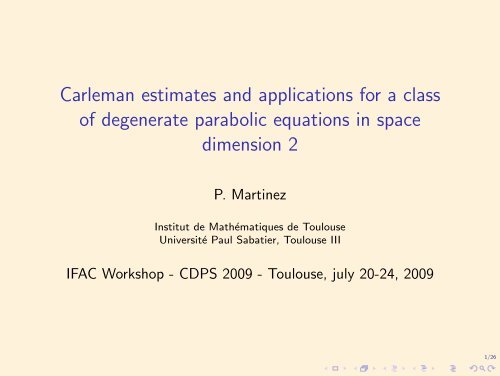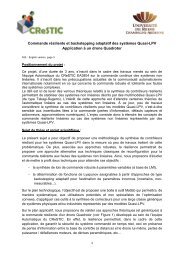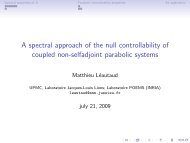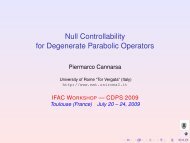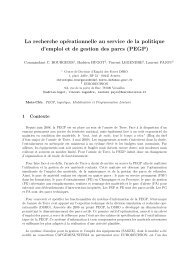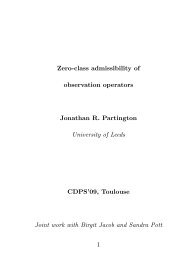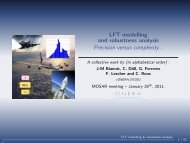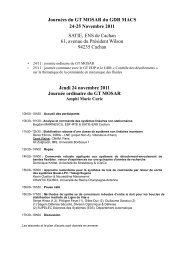Null controllability properties of some degenerate parabolic equations.
Null controllability properties of some degenerate parabolic equations.
Null controllability properties of some degenerate parabolic equations.
You also want an ePaper? Increase the reach of your titles
YUMPU automatically turns print PDFs into web optimized ePapers that Google loves.
Carleman estimates and applications for a class<br />
<strong>of</strong> <strong>degenerate</strong> <strong>parabolic</strong> <strong>equations</strong> in space<br />
dimension 2<br />
P. Martinez<br />
Institut de Mathématiques de Toulouse<br />
Université Paul Sabatier, Toulouse III<br />
IFAC Workshop - CDPS 2009 - Toulouse, july 20-24, 2009<br />
1/26
Joint work with<br />
- Piermarco Cannarsa, Univ. Tor Vergata, Roma 2,<br />
- Judith Vancostenoble, Univ. Toulouse 3,<br />
2/26
Presentation <strong>of</strong> the problem<br />
Ω bounded, smooth domain <strong>of</strong> R 2 (R n ) ; ω nonempty open subset<br />
<strong>of</strong> Ω.<br />
but non uniformly positive :<br />
A : Ω → S 2 (R), A(x) ≥ 0,<br />
∀x ∈ ∂Ω, det(A(x)) = 0.<br />
<strong>Null</strong> <strong>controllability</strong> and inverse problems <strong>properties</strong> <strong>of</strong><br />
⎧<br />
⎪⎨ u t − div (A(x)∇u) = h(x, t)χ ω ,<br />
boundary conditions,<br />
<br />
⎪⎩<br />
initial condition<br />
(First step to exact <strong>controllability</strong> to trajectories...)<br />
Uniformly positive case : heat equation Lebeau-Robbiano (95),<br />
general case : Fursikov-Imanuvilov (95,96)<br />
3/26
Some examples <strong>of</strong> such <strong>equations</strong> in 1D<br />
◮ aeronautics : the Crocco type equation (boundary layer<br />
model) :<br />
u t + a(y)u x − (b(y)u y ) y = localized control, x ∈ (0, L), y(0, 1)<br />
with a(1) = 0 = b(1) ;<br />
◮ climatology : the Budyko-Sellers model :<br />
RT t − ((1 − x 2 )T x ) x − QS(1 − α) = −I (T ), x ∈ (−1, 1);<br />
◮ economics : the Black-Scholes equation <strong>of</strong> the type :<br />
u t − x 2 u xx + · · · = · · · , x ∈ (0, L).<br />
4/26
An example in N-D<br />
◮ biology : the Fleming Viot model :<br />
u t − Tr (C(x)D 2 u) · · · = f ,<br />
where<br />
C(x) = (c ij (x)) i,j , c ij (x) = x i (δ ij − x j ),<br />
and<br />
x ∈ {x i ∈ [0, 1], ∑ i<br />
x i ≤ 1};<br />
example : N=2 : <strong>degenerate</strong> along the sides <strong>of</strong> the triangle.<br />
5/26
Main results on the 1D <strong>degenerate</strong> problems : the simplest<br />
problem<br />
The simplest problem in divergence form (Cannarsa, Martinez,<br />
Vancostenoble (2008)) :<br />
u t − (x α u x ) x = h(x, t)χ (a,b) , x ∈ (0, 1), t > 0 :<br />
◮ α ∈ [0, 1[ : well-posed with the Dirichlet boundary condition<br />
(u(0, t) = 0 = u(t, 1), and null controllable ;<br />
◮ α ∈ [1, 2[ : well-posed with the Neumann boundary condition<br />
(x α u x )(0, t) = 0 = u(1, t), and null controllable ;<br />
Main tools : Carleman estimates associated to the <strong>degenerate</strong><br />
problem, and Hardy type inequalities ;<br />
6/26
◮ α ≥ 2 : well-posed with the Neumann boundary condition<br />
(x α u x )(0, t) = 0 = u(1, t), and not null controllable ;<br />
Main tools : application <strong>of</strong> a result <strong>of</strong> Escauriaza, Seregin,<br />
Sverak (2004) related to the backward uniqueness <strong>properties</strong><br />
<strong>of</strong> the heat equation in half space.<br />
Remark : Strong connection between <strong>degenerate</strong> problems in<br />
bounded domains and non<strong>degenerate</strong> problems in unbounded<br />
domains<br />
7/26
The problem in 2D : simplest assumptions on the<br />
degeneracy<br />
A(x) ∼<br />
(<br />
λ1 (x) 0<br />
0 λ 2 (x)<br />
)<br />
with 0 ≤ λ 1 (x) ≤ λ 2 (x).<br />
ε 1 (x) denotes the eigenvector associated to λ 1 (x), and ε 2 (x) the<br />
eigenvector associated to λ 2 (x).<br />
Simplest assumptions (H s (A)) : Ω is <strong>of</strong> class C 4 , and there exists<br />
<strong>some</strong> α ≥ 0, and <strong>some</strong> neighborhood <strong>of</strong> the boundary Γ such that :<br />
◮ λ 1 (x) = d(x, Γ) α for all x ∈ V(Γ),<br />
◮ ε 1 (x) = ν(p Γ (x)) for all x ∈ V(Γ), where p Γ (x) is the<br />
projection <strong>of</strong> x on the boundary Γ,<br />
◮ 0 < m ≤ λ 2 (x) ≤ M for all x ∈ Ω.<br />
8/26
The control problem<br />
We consider<br />
⎧<br />
⎪⎨ u t − div (A(x)∇u) = h(x, t)χ ω ,<br />
boundary conditions,<br />
⎪⎩<br />
initial condition,<br />
under (H s (A)) .<br />
◮ Question 1 : well-posedness <br />
yes, in natural weighted Sobolev spaces.<br />
◮ Question 2 : null <strong>controllability</strong> : given T > 0, u 0 ∈ L 2 (Ω),<br />
does there exist h ∈ such that u(T ) = 0 <br />
9/26
<strong>Null</strong> <strong>controllability</strong> result when α ∈ [0, 1)<br />
Theorem<br />
Assume that A satisfies Hypothesis (H s (A)) with α ∈ [0, 1). Let<br />
T > 0 be given and consider ω any non-empty open subset <strong>of</strong> Ω.<br />
Then for all u 0 ∈ L 2 (Ω), there exists h ∈ L 2 (Ω T ) such that the<br />
solution u <strong>of</strong><br />
⎧<br />
⎪⎨ u t − div (A(x)∇u) = h(x, t)χ ω , x ∈ Ω, t > 0<br />
u(t, x) = 0 on Γ,<br />
⎪⎩<br />
u(0, x) = u 0 (x)<br />
satisfies u(T , ·) = 0 in L 2 (Ω). Moreover h is bounded with respect<br />
to α ∈ [0, 1) :<br />
‖h‖ L 2 (Ω×(0,T )) ≤ C(Ω, ω, T )‖u 0 ‖ L 2 (Ω).<br />
10/26
Associated observability estimate<br />
The null <strong>controllability</strong> result derives from the following<br />
observability estimate :<br />
Theorem<br />
Under (H s (A)), there is <strong>some</strong> C(Ω, ω, T ) independent <strong>of</strong> α ∈ [0, 1)<br />
such that, given v T ∈ L 2 (Ω), the solution v <strong>of</strong> the adjoint problem<br />
satisfies :<br />
∫<br />
Ω<br />
⎧<br />
⎪⎨ v t + div (A(x)∇v) = 0, x ∈ Ω, t > 0<br />
v(t, x) = 0 on Γ,<br />
⎪⎩<br />
v(T , x) = v T (x)<br />
∫ T ∫<br />
v(0, x) 2 dx ≤ C(Ω, ω, T ) v(t, x) 2 dx dt.<br />
0 ω<br />
Hence : usual observability estimate, but in the <strong>degenerate</strong> context.<br />
11/26
<strong>Null</strong> <strong>controllability</strong> result when α ∈ [1, 2)<br />
Theorem<br />
Assume that A satisfies Hypothesis (H s (A)) with α ∈ [1, 2). Let<br />
T > 0 be given and consider ω any non-empty open subset <strong>of</strong> Ω.<br />
Then for all u 0 ∈ L 2 (Ω), there exists h ∈ L 2 (Ω T ) such that the<br />
solution u <strong>of</strong><br />
⎧<br />
⎪⎨ u t − div (A(x)∇u) = h(x, t)χ ω , x ∈ Ω, t > 0<br />
A∇u(t, x) · ν = 0 on Γ (generalized Neumann condition),<br />
⎪⎩<br />
u(0, x) = u 0 (x)<br />
satisfies u(T , ·) = 0 in L 2 (Ω). Moreover there is C(Ω, , T )<br />
independent <strong>of</strong> α ∈ [1, 2) such that<br />
‖h‖ L 2 (Ω×(0,T )) ≤ e eC(Ω,ω,T )/(2−α)2 ‖u 0 ‖ L 2 (Ω).<br />
12/26
Associated observability estimate<br />
The null <strong>controllability</strong> result derives from the following<br />
observability estimate :<br />
Theorem<br />
Under (H s (A)), there is <strong>some</strong> C(Ω, ω, T ) independent <strong>of</strong> α ∈ [1, 2)<br />
such that, given v T ∈ L 2 (Ω), the solution v <strong>of</strong> the adjoint problem<br />
satisfies :<br />
∫<br />
Ω<br />
⎧<br />
⎪⎨ v t + div (A(x)∇v) = 0, x ∈ Ω, t > 0<br />
A∇v(t, x) · ν = 0 on Γ,<br />
⎪⎩<br />
v(T , x) = v T (x)<br />
∫<br />
v(0, x) 2 T ∫<br />
dx ≤ e eC(Ω,ω,T )/(2−α)2 v(t, x) 2 dx dt.<br />
0<br />
ω<br />
13/26
Comments<br />
◮ estimate on the cost <strong>of</strong> observability and <strong>controllability</strong> with<br />
respect to the degeneracy parameter α (new even in 1-D,<br />
thanks to improved Hardy type inequalities) ;<br />
◮ the bound on the control and the observability cost explode as<br />
α → 2 − ;<br />
◮ indeed : negative result in the case α ≥ 2 : counter-example :<br />
Ω = disc <strong>of</strong> radius 1 ; explicit matrix A(x) whose eigenvalues<br />
are λ 1 (x) = (1 − r) α , λ 2 (x) = 1 ;<br />
transformation to write the problem in polar coordinates : the<br />
associated function v(r, θ) is solution <strong>of</strong> a <strong>degenerate</strong> <strong>parabolic</strong><br />
equation in 2D ;<br />
the means w(r) = ∫ 2π<br />
v(r, θ) dθ is solution <strong>of</strong> a <strong>degenerate</strong><br />
0<br />
<strong>parabolic</strong> equation in 1D, for which we already know that there<br />
is no null <strong>controllability</strong> ;<br />
return to the initial problem : no null <strong>controllability</strong> ;<br />
14/26
Extensions<br />
◮ more general <strong>degenerate</strong> <strong>parabolic</strong> problem<br />
u t − div (A(x)∇u) + b(x) · ∇u + c(x)u = h(x, t)χ ω ,<br />
when (b, ε 1 ) = O(d Γ (x) α/2 , (b, ε 2 ) = O(1), c bounded : same<br />
results.<br />
◮ weakened assumptions on the degeneracy : (H g (A)) : there<br />
exists <strong>some</strong> α ≥ 0 such that :<br />
λ 1 (x) ∼ d(x, Γ) α as x → Γ,<br />
ε 1 (x) − ν(p Γ (x)) → 0 as x → Γ,<br />
0 < m ≤ λ 2 (x) ≤ M for all x ∈ Ω.<br />
(work in progress)<br />
15/26
Main steps in the pro<strong>of</strong> <strong>of</strong> the positive results (α ∈ [0, 2))<br />
The observability results derives from a Carleman estimate related<br />
to the <strong>degenerate</strong> problem :<br />
◮ “<strong>some</strong>” computations,<br />
◮ <strong>some</strong> useful tools : a special geometrical lemma, and special<br />
Hardy type inequalities,<br />
What does not help :<br />
◮ the operator is <strong>degenerate</strong>,<br />
◮ the solution is not regular enough (u(t, .) ∈ HA 2 (Ω) that<br />
strictly contains H 2 (Ω)) ;<br />
What helps :<br />
◮ the degeneracy occurs only on the boundary, in a very<br />
specified way ((H s (A)) or (H g (A))),<br />
◮ the solution has <strong>some</strong> sufficient regularity (proved in the thesis<br />
<strong>of</strong> D. Rocchetti, Univ Roma 2, 2008).<br />
16/26
Useful 1-D Hardy type inequalities<br />
The simplest one :<br />
Lemma<br />
Given L > 0 and α ∈ [0, 1), then the following inequality holds for<br />
all z ∈ D((0, L])<br />
∫ L<br />
0<br />
x α−2 z(x) 2 dx ≤<br />
∫<br />
4 L<br />
(1 − α) 2 x α z x (x) 2 dx.<br />
0<br />
Comments :<br />
◮ natural extension by density to absolutely continuous<br />
functions z such that<br />
z(x) → 0<br />
x→0 +<br />
and<br />
◮ the constant<br />
4<br />
(1−α) 2 is optimal ;<br />
◮ the result is false for α = 1 ;<br />
◮ similar version for α ∈ (1, 2).<br />
∫ L<br />
0<br />
x α z x (x) 2 dx < ∞;<br />
17/26
Pro<strong>of</strong> : several ones, but probably the most simple one :<br />
0 ≤<br />
∫ L<br />
=<br />
(<br />
0<br />
∫ L<br />
0<br />
x α/2 z x − 1 − α<br />
2<br />
x z) (α−2)/2 dx<br />
2<br />
x α z 2 x +<br />
(1 − α)2<br />
4<br />
∫ L<br />
Then an integration by parts leads to<br />
0 ≤<br />
Hence<br />
∫ L<br />
0<br />
x α z 2 x +<br />
(1 − α)2<br />
4<br />
∫ L<br />
0<br />
0<br />
x α−2 z 2 − 1 − α<br />
2<br />
x α−2 z 2<br />
− 1 − α L α−1 z(L) 2 +<br />
2<br />
(1 − α)<br />
2<br />
∫ L<br />
0<br />
∫ L<br />
0<br />
x α−1 (z 2 ) x .<br />
(α − 1)x α−2 z 2 .<br />
(1 − α) 2<br />
4<br />
∫ L<br />
0<br />
x α−2 z 2 ≤<br />
∫ L<br />
0<br />
x α zx 2 − 1 − α L α−1 z(L) 2<br />
2<br />
≤<br />
∫ L<br />
0<br />
x α z 2 x .<br />
18/26
A useful improved version (J. Vancostenoble) :<br />
Lemma<br />
Given L > 0, α ∈ [0, 1), β > 0, n > 0, there exists<br />
C β,n = C(L, β, n) > 0 and x β,n = x(L, β, n) ∈ (0, L) such that the<br />
following inequality holds : for all z ∈ D((0, L])<br />
(1 − α) 2<br />
4<br />
∫ L<br />
0<br />
x α−2 z(x) 2 dx + n<br />
≤<br />
∫ L<br />
0<br />
∫ L<br />
0<br />
x α−2+β z(x) 2 dx<br />
x α z x (x) 2 dx + C β,n<br />
∫ L<br />
x β,n<br />
z(x) 2 dx. (1)<br />
◮ it allows us to estimate “non critical” terms <strong>of</strong> the form<br />
∫ L<br />
0 xα−2+β z(x) 2 dx uniformly with respect to α ∈ [0, 1) ;<br />
◮ it remains valid for α ∈ [1, 2), in particular for α = 1 ;<br />
◮ it is the key to obtain the observability cost estimates.<br />
19/26
Pro<strong>of</strong> : the main step is to prove it for z ∈ D((0, L)) :<br />
∫ L<br />
(<br />
0 ≤ x α/2 z x − 1 − α<br />
2<br />
x (α−2)/2 z + x z) (α−2+β)/2 dx<br />
2<br />
0<br />
gives (integrations by parts)<br />
(1 − α) 2<br />
4<br />
∫ L<br />
0<br />
≤<br />
x α−2 z 2 + n<br />
∫ L<br />
0<br />
x α z 2 x +<br />
∫ L<br />
0<br />
∫ L<br />
0<br />
x α−2+β z 2<br />
(<br />
(n + 1)x β/2 − β )<br />
x α−2+β/2 z 2 .<br />
2<br />
Since β > 0, we have<br />
(n + 1)x β/2 − β ( )<br />
2 ≤ 0 for all x ∈ [0, β 2/β<br />
];<br />
2(n + 1)<br />
therefore<br />
(1 − α) 2<br />
4<br />
∫ L<br />
0<br />
x α−2 z 2 + n<br />
≤<br />
∫ L<br />
0<br />
∫ L<br />
0<br />
x α−2+β z 2<br />
x α z 2 x + C 1 (L, α, β, n)<br />
∫ L<br />
x 1<br />
z 2 .<br />
20/26
Useful 2-D (N-D) Hardy type inequalities<br />
◮ normal parametrization <strong>of</strong> the boundary by arclength :<br />
Γ = γ([0, l(Γ)]), γ(0) = γ(l(Γ)), |γ ′ (t)| = 1 ;<br />
◮ this gives a parametrization <strong>of</strong> the neighborhood C(Γ, η) <strong>of</strong> Γ :<br />
ψ : [0, l(Γ)] × (0, η) → C(Γ, η), ψ(s, t) = γ(s) − tν(γ(s)) :<br />
ψ is a C 1 -diffeomorphism between (0, l(Γ)) × (0, η) and<br />
C(Γ, η) \ ψ({0} × (0, η)) ;<br />
◮ then use the 1-D hardy type inequality on every normal<br />
segment, and integrate over Γ :<br />
∫∫<br />
C(Γ,η)<br />
∫ ( ∫<br />
d Γ (x) α−2 z 2 η<br />
=<br />
≤ HARDY<br />
∫<br />
Γ<br />
(<br />
Γ<br />
0<br />
∫<br />
4 η<br />
(α − 1) 2<br />
)<br />
“d Γ (x) α−2 z 2 “<br />
0<br />
)<br />
“d Γ (x) α (∇z · ν) 2 “<br />
c<br />
≤<br />
(α − 1)<br />
∫∫C(Γ,η)<br />
2 d Γ (x) α (∇z · ν) 2<br />
21/26
The standard form <strong>of</strong> the Carleman estimate<br />
We consider the solution <strong>of</strong> the adjoint problem<br />
⎧<br />
⎪⎨ w t + div (A(x)∇w) = f , x ∈ Ω, t > 0,<br />
w(t, x) = 0 on Γ,<br />
⎪⎩<br />
w(T , x) = w T (x).<br />
A Carleman estimate will be <strong>of</strong> the type<br />
∫∫<br />
weight 0 w 2 + weight 1 |∇w| 2 + weight 2 |D 2 w| 2 + weight 3 wt<br />
2<br />
Ω T<br />
∫∫<br />
∫∫<br />
≤ C weight 4 f 2 + C weight 5 w 2 ,<br />
Ω T ω T<br />
hence a <strong>parabolic</strong> regularity type result, but without involving<br />
‖w T ‖.<br />
22/26
How to obtain the Carleman estimate : the method and<br />
the difficulties<br />
◮ description <strong>of</strong> the method : the weighted function<br />
z(t, x) := e −Rσ w satisfies the differential problem :<br />
and so<br />
P + R z + P− R z = fe−Rσ ,<br />
‖P + R z‖2 + ‖P − R z‖2 + 2〈P + R z, P− R z〉 = ‖fe−Rσ ‖ 2 ,<br />
and the Carleman estimates comes from a suitable lower<br />
bound <strong>of</strong> the scalar product 〈P + R z, P− R z〉.<br />
◮ the difficulties due to the degeneracy :<br />
adapt all the weights to the degeneracy ; and use suitable<br />
Hardy type inequalities ;<br />
the solution has no enough global regularity : compute on<br />
subdomains Ω δ := {x ∈ Ω, d(x, Γ) > δ}, and pass to the limit<br />
Ω δ → Ω and Γ δ → Γ for the boundary integrals (using<br />
<strong>properties</strong> <strong>of</strong> W 1,1 functions).<br />
23/26
The weights that finally appear are :<br />
◮ <strong>degenerate</strong> in time : classical and natural, since we do not<br />
want to make appear w(T ) ;<br />
◮ <strong>degenerate</strong> in space : equal to zero on the boundary, because<br />
<strong>of</strong> the degeneracy <strong>of</strong> the operator :<br />
∫∫<br />
(2 − α) ρ 3 e −2Rσ d Γ (x) 2−α w 2<br />
Ω T<br />
∫∫<br />
+ (2 − α) ρe −2Rσ A(x)∇w · ∇w<br />
Ω<br />
∫∫ T<br />
∫∫<br />
≤ C e −2Rσ f 2 + C ρ 3 e −2Rσ w 2 .<br />
Ω T ω T<br />
In particular, these estimates require α < 2.<br />
And we have also similar estimates for w t , D 2 w.<br />
24/26
But the Hardy type inequalities allow (once again) to correct this<br />
when α < 2, and to obtain in particular<br />
∫∫<br />
(2 − α) ρ 3/2 e −2Rσ w 2<br />
Ω T<br />
∫∫<br />
≤ C e −2Rσ f 2 + C<br />
Ω T<br />
∫∫<br />
ω T<br />
ρ 3 e −2Rσ w 2 ,<br />
which implies the desired observability inequality, and to estimate<br />
the observability cost with respect to the degeneracy parameter :<br />
∫<br />
Ω<br />
w(0, x) 2 dx ≤ 2 T<br />
∫ 3T /4<br />
T /4<br />
∫<br />
Ω<br />
w(t, x) 2 dx<br />
∫∫<br />
≤ C(Ω, ω, T , α) ρ 3/2 e −2Rσ w 2 ≤ · · ·<br />
Ω T<br />
25/26
Applications <strong>of</strong> the obtained Carleman estimate<br />
◮ the observability inequalities (α ∈ [0, 1) and α ∈ [1, 2)), and<br />
then the related null <strong>controllability</strong> results ;<br />
◮ inverse problems results (more appropriate for biological and<br />
climate models) : suitably adapting the methods developped<br />
in particular by O. Imanuvilov, M. Yamamoto, A.<br />
Benabdallah, P. Gaitan, J. Le Rousseau :<br />
determination <strong>of</strong> a source, <strong>of</strong> a potential term (in particular :<br />
concerning Budyko-Sellers type problems :<br />
Cannarsa-Tort-Yamamoto, work in progress)<br />
<strong>of</strong> a diffusion coefficient (work in progress), ...<br />
measuring the solution at <strong>some</strong> time, and in a part <strong>of</strong> the<br />
space domain.<br />
26/26


